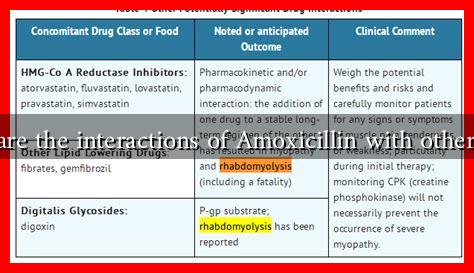-
Table of Contents
What are the Interactions of Amoxicillin with Other Drugs?
Amoxicillin is a widely used antibiotic that belongs to the penicillin group of drugs. It is effective against a variety of bacterial infections, including those affecting the ears, nose, throat, urinary tract, and skin. While amoxicillin is generally considered safe, it can interact with other medications, leading to reduced efficacy or increased risk of side effects. Understanding these interactions is crucial for both healthcare providers and patients. This article explores the interactions of amoxicillin with other drugs, providing valuable insights into safe medication practices.
Common Drug Interactions with Amoxicillin
Amoxicillin can interact with several classes of medications. Here are some of the most notable interactions:
- Anticoagulants: Amoxicillin may enhance the effects of anticoagulants like warfarin, increasing the risk of bleeding. Patients on these medications should have their INR levels monitored closely.
- Oral Contraceptives: Some studies suggest that amoxicillin may reduce the effectiveness of hormonal contraceptives, leading to unintended pregnancies. Women using birth control pills should consider additional contraceptive methods while taking amoxicillin.
- Probenecid: This medication, used to treat gout, can increase the levels of amoxicillin in the blood by inhibiting its renal excretion. This may enhance the antibiotic’s effects but also increase the risk of side effects.
- Other Antibiotics: Combining amoxicillin with other antibiotics, such as tetracyclines, can lead to antagonistic effects, reducing the overall efficacy of treatment.
Mechanisms of Interaction
The interactions of amoxicillin with other drugs can occur through various mechanisms:
- Altered Metabolism: Some drugs can affect the liver enzymes responsible for metabolizing amoxicillin, leading to increased or decreased drug levels in the body.
- Renal Excretion: Drugs that affect kidney function can alter the excretion of amoxicillin, impacting its therapeutic levels.
- Protein Binding: Amoxicillin is highly protein-bound. Drugs that displace amoxicillin from its protein-binding sites can increase its free concentration in the bloodstream, potentially leading to toxicity.
Case Studies and Statistics
Several studies have highlighted the importance of monitoring drug interactions with amoxicillin. For instance, a study published in the Journal of Antimicrobial Chemotherapy found that patients taking amoxicillin alongside warfarin had a significantly higher risk of bleeding complications. The study reported that 30% of patients experienced elevated INR levels, necessitating dosage adjustments of warfarin.
Another case study involved a 28-year-old woman who became pregnant while taking amoxicillin and oral contraceptives. Despite adherence to her birth control regimen, she experienced a contraceptive failure attributed to the antibiotic’s interaction. This case underscores the need for healthcare providers to counsel patients on potential interactions with hormonal contraceptives.
Recommendations for Patients and Healthcare Providers
To minimize the risk of adverse interactions, both patients and healthcare providers should take the following precautions:
- Medication Review: Always inform your healthcare provider about all medications you are taking, including over-the-counter drugs and supplements.
- Monitor for Side Effects: Be vigilant for any unusual symptoms or side effects when starting amoxicillin, especially if you are on other medications.
- Consult Before Combining: Before starting any new medication, consult with your healthcare provider to assess potential interactions with amoxicillin.
- Regular Check-ups: Schedule regular follow-ups to monitor the effectiveness of treatment and adjust dosages as necessary.
Conclusion
Amoxicillin is a powerful antibiotic that can effectively treat various bacterial infections. However, its interactions with other drugs can pose significant risks. Understanding these interactions is essential for ensuring safe and effective treatment. By being aware of potential drug interactions and taking proactive measures, patients and healthcare providers can work together to optimize antibiotic therapy and minimize adverse effects. Always consult with a healthcare professional before making any changes to your medication regimen.



